Pig manure (PM) is often highly enriched in heavy metals, such as Cu and Zn, due to the wide use of feed additives. To study the potential risks of heavy metal accumulation in the soil and rice grains by the application of PM and other organic manure, a four-year field experiment was conducted in the suburb of Shanghai, southeast China. The contents of Cu, Zn, Pb, and Cd in the soils and rice plants by the treatments of PM and fungal culturing residues (FCR) show a trend of annual increase. Those in the soils and rice by the PM treatment are raised even more significantly. Cu and Zn contents in the soil and rice roots by the PM are significantly higher than those by the non-fertilizer control (CK) during the four years, and Pb and Cd also significantly higher than CK in the latter two years.
- pig manure (PM)
- fungal culturing residues (FCR)
- rice
- heavy metal
- soils
1. Introduction
2. Enhancements of Soil Nutrients by Application of PM and FCR
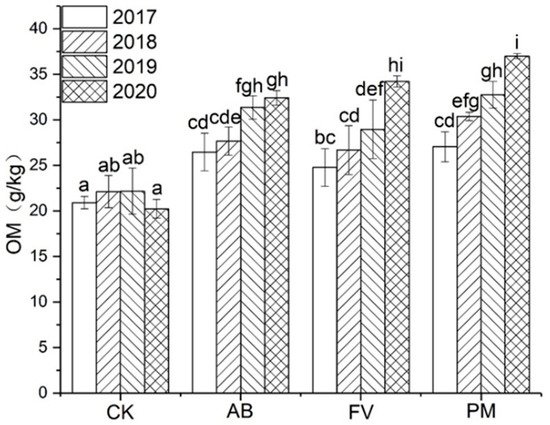
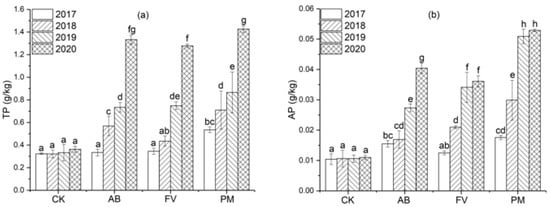
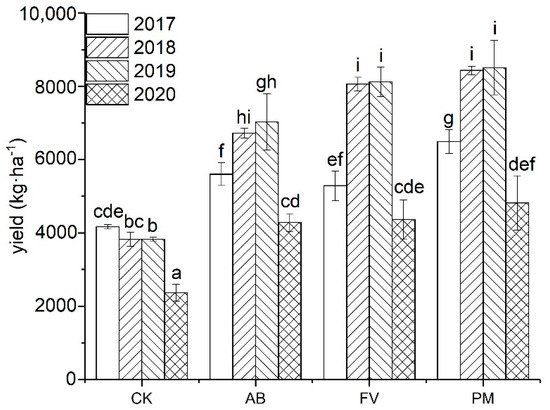
3. Accumulation of Heavy Metals in the Soils Caused by Application of PM and FCR
| Organic Fertilizer | pH | OM (%) | Water Content (%) | TN (g/kg) | TP (g/kg) | TK (g/kg) | Cu (mg/kg) | Zn (mg/kg) | Pb (mg/kg) | Cd (mg/kg) |
|---|---|---|---|---|---|---|---|---|---|---|
| FV | 5.50 ± 0.11 | 71.75 ± 0.89 | 77.66 ± 0.13 | 20.34 ± 0.26 | 10.20 ± 0.09 | 3.07 ± 0.07 | 8.00 ± 0.81c | 33.46 ± 5.95c | 0.52 ± 0.16 c | 0.15 ± 0.05 c |
| AB | 5.85 ± 0.16 | 36.49 ± 0.63 | 75.63 ± 0.12 | 19.24 ± 0.31 | 4.36 ± 0.05 | 2.65 ± 0.15 | 30.09 ± 0.49b | 123.72 ± 6.52b | 1.71 ± 0.43 b | 0.30 ± 0.05 b |
| PM | 6.99 ± 0.19 | 33.81 ± 0.55 | 12.04 ± 0.15 | 21.05 ± 0.18 | 15.43 ± 0.16 | 3.76 ± 0.21 | 166.76 ± 19.99a | 544.74 ± 75.48a | 3.20 ± 0.14 a | 0.43 ± 0.03 a |
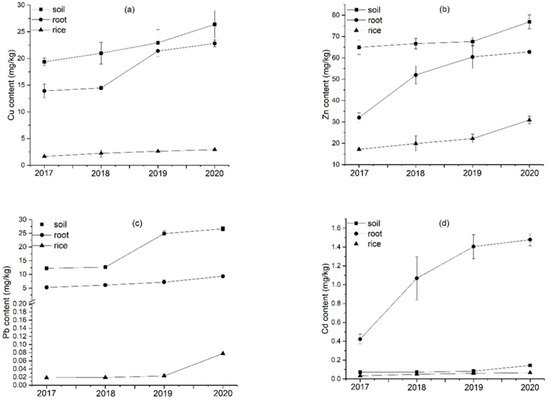
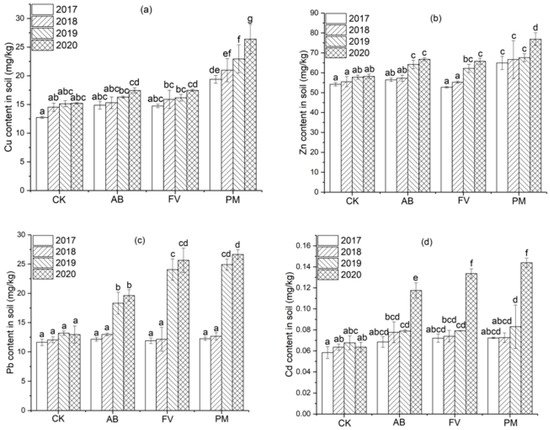
4. Distribution of Heavy Metals in Rice Plants
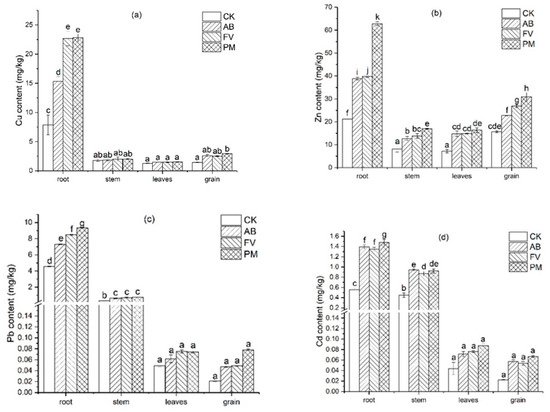
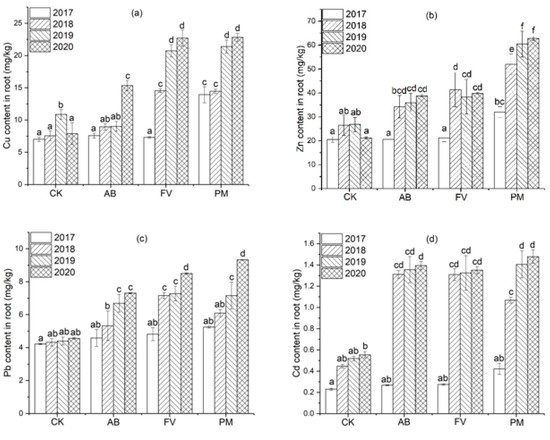
5. Risk of Heavy Metal Contamination in Rice Grain Caused by Application of PM and FCR
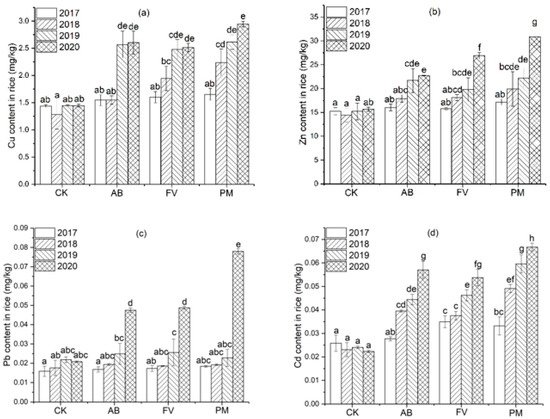
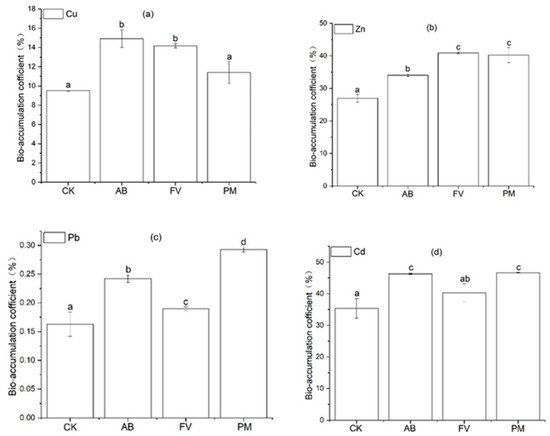
This entry is adapted from the peer-reviewed paper 10.3390/plants11020207
References
- Uphoff, N.; Dazzo, F.B. Making Rice Production More Environmentally-Friendly. Environments 2016, 3, 12.
- Qian, X.; Wang, Z.; Shen, G.; Chen, X.; Tang, Z.; Guo, C.; Gu, H.; Fu, K. Heavy metals accumulation in soil after 4 years of continuous land application of swine manure: A field-scale monitoring and modeling estimation. Chemosphere 2018, 210, 1029–1034.
- Onwosi, C.O.; Igbokwe, V.C.; Odimba, J.N.; Eke, I.E.; Nwankwoala, M.O.; Iroh, I.N.; Ezeogu, L.I. Composting technology in waste stabilization: On the methods, challenges and future prospects. J. Environ. Manag. 2017, 190, 140–157.
- Cai, A.; Xu, M.; Wang, B.; Zhang, W.; Liang, G.; Hou, E.; Luo, Y. Manure acts as a better fertilizer for increasing crop yields than synthetic fertilizer does by improving soil fertility. Soil Tillage Res. 2019, 189, 168–175.
- Stroppa, N.; Onelli, E.; Hejna, M.; Rossi, L.; Gagliardi, A.; Bini, L.; Baldi, A.; Moscatelli, A. Typha latifolia and Thelypteris palustris behavior in a pilot system for the refinement of livestock wastewaters: A case of study. Chemosphere 2020, 240, 14.
- Jin, H.; Chang, Z. Distribution of heavy metal contents and chemical fractions in anaerobically digested manure slurry. Appl. Biochem. Biotechnol. 2011, 164, 268–282.
- Huang, H.; Li, B.; Li, J.; Zhang, P.; Yu, W.; Zhao, N.; Guo, G.; Young, B. Influence of process parameters on the heavy metal (Zn(2+), Cu(2+) and Cr(3+)) content of struvite obtained from synthetic swine wastewater. Environ. Pollut. 2019, 245, 658–665.
- Mu, H.Y.; Zhuang, Z.; Li, Y.M.; Qiao, Y.H.; Chen, Q.; Xiong, J.; Guo, L.L.; Jiang, R.F.; Li, H.-F. Heavy Metal Contents in Animal Manure in China and the Related Soil Accumulation Risks. Huan Jing Ke Xue 2020, 41, 986–996.
- Franco, A.; Schuhmacher, M.; Roca, E.; Luis, D.J. Application of cattle manure as fertilizer in pastureland: Estimating the incremental risk due to metal accumulation employing a multicompartment model. Environ. Int. 2006, 32, 724–732.
- Yang, X.; Li, Q.; Tang, Z.; Zhang, W.; Yu, G.; Shen, Q.; Zhao, F.J. Heavy metal concentrations and arsenic speciation in animal manure composts in China. Waste Manag. 2017, 64, 333–339.
- Sager, M. Trace and nutrient elements in manure, dung and compost samples in Austria. Soil Biol. Biochem. 2007, 39, 1383–1390.
- Shi, J.; Yu, X.; Zhang, M.; Lu, S.; Wu, W.; Wu, J.; Xu, J. Potential Risks of Copper, Zinc, and Cadmium Pollution due to Pig Manure Application in a Soil-Rice System under Intensive Farming: A Case Study of Nanhu, China. J. Environ. Qual. 2011, 40, 1695–1704.
- Zhang, F.; Li, Y.; Yang, M.; Li, W. Content of Heavy Metals in Animal Feeds and Manures from Farms of Different Scales in Northeast China. Int. J. Environ. Res. Public Health 2012, 9, 2658–2668.
- Xu, Y.; Yu, W.; Ma, Q.; Zhou, H. Accumulation of copper and zinc in soil and plant within ten-year application of different pig manure rates. Plant. Soil Environ. 2013, 59, 492–499.
- Zhao, Y.; Yan, Z.; Qin, J.; Xiao, Z. Effects of long-term cattle manure application on soil properties and soil heavy metals in corn seed production in Northwest China. Environ. Sci. Pollut. Res. 2014, 21, 7586–7595.
- Liang, X.; Jin, Y.; He, M.; Liu, Y.; Hua, G.; Wang, S.; Tian, G. Composition of phosphorus species and phosphatase activities in a paddy soil treated with manure at varying rates. Agric. Ecosyst. Environ. 2017, 237, 173–180.
- Liang, Y.G.; Li, X.J.; Zhang, J.; Zhang, L.G.; Cheng, B. Effect of microscale ZVI/magnetite on methane production and bioavailability of heavy metals during anaerobic digestion of diluted pig manure. Environ. Sci. Pollut. Res. 2017, 24, 12328–12337.
- Cang, L.; Wang, Y.J.; Zhou, D.M.; Dong, Y.H. Heavy metals pollution in poultry and livestock feeds and manures under intensive farming in Jiangsu Province, China. J. Environ. Sci. 2004, 16, 371–374.
- Peng, S.; Wang, Y.; Zhou, B.; Lin, X. Long-term application of fresh and composted manure increase tetracycline resistance in the arable soil of eastern China. Sci. Total Environ. 2015, 506–507, 279–286.
- Meng, J.; Liang, S.; Tao, M.; Liu, X.; Brookes, P.C.; Xu, J. Chemical speciation and risk assessment of Cu and Zn in biochars derived from co-pyrolysis of pig manure with rice straw. Chemosphere 2018, 200, 344–350.
- Muthayya, S.; Sugimoto, J.D.; Montgomery, S.; Maberly, G.F. An overview of global rice production, supply, trade, and consumption. Ann. N. Y. Acad. Sci. 2014, 1324, 7–14.
- Gu, J.F.; Zhou, H.; Tang, H.L.; Yang, W.T.; Zeng, M.; Liu, Z.M.; Peng, P.Q.; Liao, B.H. Cadmium and arsenic accumulation during the rice growth period under in situ remediation. Ecotoxicol. Environ. Saf. 2019, 171, 451–459.
- Zhou, H.; Zhu, W.; Yang, W.T.; Gu, J.F.; Gao, Z.X.; Chen, L.W.; Du, W.Q.; Zhang, P.; Peng, P.Q.; Liao, B.H. Cadmium uptake, accumulation, and remobilization in iron plaque and rice tissues at different growth stages. Ecotoxicol. Environ. Saf. 2018, 152, 91–97.
- Shan, H.; Su, S.; Liu, R.; Li, S. Cadmium availability and uptake by radish (Raphanus sativus) grown in soils applied with wheat straw or composted pig manure. Environ. Sci. Pollut. Res. 2016, 23, 15208–15217.
- Qian, X.; Shen, G.; Wang, Z.; Zhang, X.; Hong, Z. Effect of swine liquid manure application in paddy field on water quality, soil fertility and crop yields. Paddy Water Environ. 2018, 16, 15–22.
- Demelash, N.; Bayu, W.; Tesfaye, S.; Ziadat, F.; Sommer, R. Current and residual effects of compost and inorganic fertilizer on wheat and soil chemical properties. Nutr. Cycl. Agroecosyst. 2014, 100, 357–367.
- Carpenter, S.R.; Caraco, N.F.; Correll, D.L.; Howarth, R.W.; Sharpley, A.N.; Smith, V.H. Nonpoint pollution of surface waters with phosphorus and nitrogen. Ecol. Appl. 1998, 8, 559–568.
- Li, F.; Li, Z.; Mao, P.; Li, Y.; Li, Y.; McBride, M.B.; Wu, J.; Zhuang, P. Heavy metal availability, bioaccessibility, and leachability in contaminated soil: Effects of pig manure and earthworms. Environ. Sci. Pollut. Res. 2019, 26, 20030–20039.
- Antonious, G.F.; Kochhar, T.S.; Coolong, T. Yield, quality, and concentration of seven heavy metals in cabbage and broccoli grown in sewage sludge and chicken manure amended soil. J. Environ. Sci. Health Part A—Toxic/Hazard. Subst. Environ. Eng. 2012, 47, 1955–1965.
- Liu, D.Y.; Zhang, W.; Pang, L.L.; Zhang, Y.Q.; Wang, X.Z.; Liu, Y.M.; Chen, X.P.; Zhang, F.S.; Zou, C.Q. Effects of zinc application rate and zinc distribution relative to root distribution on grain yield and grain Zn concentration in wheat. Plant Soil 2017, 411, 167–178.
- Liu, D.Y.; Zhang, W.; Yan, P.; Chen, X.P.; Zhang, F.S.; Zou, C.Q. Soil application of zinc fertilizer could achieve high yield and high grain zinc concentration in maize. Plant Soil 2017, 411, 47–55.
- Wei, W.; Yan, Y.; Cao, J.; Christie, P.; Zhang, F.; Fan, M. Effects of combined application of organic amendments and fertilizers on crop yield and soil organic matter: An integrated analysis of long-term experiments. Agric. Ecosyst. Environ. 2016, 225, 86–92.
- Hu, N.; Wang, B.; Gu, Z.; Tao, B.; Zhang, Z.; Hu, S.; Zhu, L.; Meng, Y. Effects of different straw returning modes on greenhouse gas emissions and crop yields in a rice-wheat rotation system. Agric. Ecosyst. Environ. 2016, 223, 115–122.
- Zhang, L.; Zheng, J.; Chen, L.; Shen, M.; Zhang, X.; Zhang, M.; Bian, X.; Zhang, J.; Zhang, W. Integrative effects of soil tillage and straw management on crop yields and greenhouse gas emissions in a rice-wheat cropping system. Eur. J. Agron. 2015, 63, 47–54.
- Irshad, M.; Malik, A.H.; Shaukat, S.; Mushtaq, S.; Ashraf, M. Characterization of Heavy Metals in Livestock Manures. Pol. J. Environ. Stud. 2013, 22, 1257–1262.
- Li, Y.X.; Li, W.; Wu, J.; Xu, L.C.; Su, Q.H.; Xiong, X. Contribution of additives Cu to its accumulationin pig feces: Study in Beijing and Fuxin of China. J. Environ. Sci. 2007, 19, 610–615.
- Dach, J.; Starmans, D. Heavy metals balance in Polish and Dutch agronomy: Actual state and previsions for the future. Agric. Ecosyst. Environ. 2005, 107, 309–316.
- Tan, C.Y.; Wu, L.H.; Luo, Y.M.; Xu, J.M.; Han, X.Z.; Qiao, Y.F. Cadmium accumulation and its development tendency in black soil under long-term fertilization. J. Appl. Ecol. 2008, 19, 2738–2744.
- Karami, M.; Amini, M.; Afyuni, M.; Khoshgoftarmanesh, A.H.; Keller, A.; Abdi, A.; Schulin, R. Agricultural zinc fluxes into soils and crops of central Iran at regional scale. Arch. Agron. Soil Sci. 2014, 60, 437–456.
- McBride, M.B.; Spiers, G. Trace element content of selected fertilizers and dairy manures as determined by ICP-MS. Commun. Soil Sci. Plant Anal. 2001, 32, 139–156.
- Luo, L.; Ma, Y.; Zhang, S.; Wei, D.; Zhu, Y.G. An inventory of trace element inputs to agricultural soils in China. J. Environ. Manag. 2009, 90, 2524–2530.
- Wu, L.; Tan, C.; Liu, L.; Zhu, P.; Peng, C.; Luo, Y.; Christie, P. Cadmium bioavailability in surface soils receiving long-term applications of inorganic fertilizers and pig manure. Geoderma 2012, 173, 224–230.
- Dudka, S.; Miller, W.P. Accumulation of potentially toxic elements in plants and their transfer to human food chain. J. Environ. Sci. Health Part B Pestic. Food Contam. Agric. Wastes 1999, 34, 681–708.
- Gong, Q.; Chen, P.; Shi, R.; Gao, Y.; Zheng, S.A.; Xu, Y.; Shao, C.; Zheng, X. Health Assessment of Trace Metal Concentrations in Organic Fertilizer in Northern China. Int. J. Environ. Res. Public Health 2019, 16, 1031.
- Kirkham, M.B. Cadmium in plants on polluted soils: Effects of soil factors, hyperaccumulation, and amendments. Geoderma 2006, 137, 19–32.
- Xu, Y.G.; Yu, W.T.; Ma, Q.; Zhou, H. Potential risk of cadmium in a soil-plant system as a result of long-term (10 years) pig manure application. Plant Soil Environ. 2015, 61, 352–357.
- Guo, G.; Lei, M.; Chen, T.; Yang, J. Evaluation of different amendments and foliar fertilizer for immobilization of heavy metals in contaminated soils. J. Soils Sediments 2018, 18, 239–247.
- Wang, X.; Zheng, G.; Chen, T.; Shi, X.; Wang, Y.; Nie, E.; Liu, J. Effect of phosphate amendments on improving the fertilizer efficiency and reducing the mobility of heavy metals during sewage sludge composting. J. Environ. Manag. 2019, 235, 124–132.
- Guo, T.; Lou, C.; Zhai, W.; Tang, X.; Hashmi, M.Z.; Murtaza, R.; Li, Y.; Liu, X.; Xu, J. Increased occurrence of heavy metals, antibiotics and resistance genes in surface soil after long-term application of manure. Sci. Total Environ. 2018, 635, 995–1003.
- Basar, H. Methods for Estimating Phytoavailable Metals in Soils. Commun. Soil Sci. Plant Anal. 2009, 40, 1087–1105.
- Shaheen, S.M.; Rinklebe, J. Impact of emerging and low cost alternative amendments on the (im)mobilization and phytoavailability of Cd and Pb in a contaminated floodplain soil. Ecol. Eng. 2015, 74, 319–326.
- Halim, M.A.; Majumder, R.K.; Zaman, M.N. Paddy soil heavy metal contamination and uptake in rice plants from the adjacent area of Barapukuria coal mine, northwest Bangladesh. Arab. J. Geosci. 2015, 8, 3391–3401.
- Sprynskyy, M.; Kowalkowski, T.; Tutu, H.; Cozmuta, L.M.; Cukrowska, E.M.; Buszewski, B. The Adsorption Properties of Agricultural and Forest Soils Towards Heavy Metal Ions (Ni, Cu, Zn, and Cd). Soil Sediment Contam. 2011, 20, 12–29.
- GB NY-525-(2012) Organic Manure Standard. Available online: https://img.antpedia.com/standard/files/pdfs_ora/CN-NY/30e/NY%20525-2012_2500.pdf (accessed on 9 January 2022).
- McLaughlin, M.J.; Parker, D.R.; Clarke, J.M. Metals and micronutrients—Food safety issues. Field Crops Res. 1999, 60, 143–163.
- Xiong, X.; Li, Y.; Li, W.; Lin, C.; Han, W.; Yang, M. Copper content in animal manures and potential risk of soil copper pollution with animal manure use in agriculture. Resour. Conserv. Recycl. 2010, 54, 985–990.
- Wan, Y.; Huang, Q.; Wang, Q.; Yu, Y.; Su, D.; Qiao, Y.; Li, H. Accumulation and bioavailability of heavy metals in an acid soil and their uptake by paddy rice under continuous application of chicken and swine manure. J. Hazard. Mater. 2020, 384, 121293.
- Merrington, G.; Madden, C. Changes in cadmium and zinc phytoavailability in agricultural soil after amendment with papermill sludge and biosolids. Commun. Soil Sci. Plant Anal. 2000, 31, 759–776.
- Weggler-Beaton, K.; McLaughlin, M.J.; Graham, R.D. Salinity increases cadmium uptake by wheat and Swiss chard from soil amended with biosolids. Aust. J. Soil Res. 2000, 38, 37–45.
- GB 15618-(2018). Environmental Quality Standards for Soils. Part 7.2: Level 2 of Environmental Quality Standards for Soil Inorganic Matter. Available online: https://img.antpedia.com/standard/files/pdfs_ora/20200926/GB%2015618-2018.pdf (accessed on 9 January 2022).
- Ochoa, M.; Tierra, W.; Santiago Tupuna-Yerovi, D.; Guanoluisa, D.; Luis Otero, X.; Ruales, J. Assessment of cadmium and lead contamination in rice farming soils and rice (Oryza sativa L.) from Guayas province in Ecuador. Environ. Pollut. 2020, 260, 114050.
- Bingham, F.T. Bioavailability of Cd to Food crops in relation to heavy metal content of sludge-amended soil. Environ. Health Perspect. 1979, 28, 39–43.
- Song, W.E.; Chen, S.B.; Liu, J.F.; Chen, L.; Song, N.N.; Li, N.; Liu, B. Variation of Cd concentration in various rice cultivars and derivation of cadmium toxicity thresholds for paddy soil by species-sensitivity distribution. J. Integr. Agric. 2015, 14, 1845–1854.
- Harris, N.S.; Taylor, G.J. Cadmium uptake and partitioning in durum wheat during grain filling. BMC Plant Biol. 2013, 13, 103.
- Yoneyama, T.; Gosho, T.; Kato, M.; Goto, S.; Hayashi, H. Xylem and phloem transport of Cd, Zn and Fe into the grains of rice plants (Oryza sativa L.) grown in continuously flooded Cd-contaminated soil. Soil Sci. Plant Nutr. 2010, 56, 445–453.
- Ashraf, U.; Kanu, A.S.; Deng, Q.; Mo, Z.; Pan, S.; Tian, H.; Tang, X. Lead (Pb) Toxicity; Physio-Biochemical Mechanisms, Grain Yield, Quality, and Pb Distribution Proportions in Scented Rice. Front. Plant Sci. 2017, 8, 259.
- Chen, H.; Tang, Z.; Wang, P.; Zhao, F.J. Geographical variations of cadmium and arsenic concentrations and arsenic speciation in Chinese rice. Environ. Pollut. 2018, 238, 482–490.
- Jarup, L.; Akesson, A. Current status of cadmium as an environmental health problem. Toxicol. Appl. 2009, 238, 201–208.
- Chen, Z.F.; Zhao, Y.; Zhu, Y.; Yang, X.; Qiao, J.; Tian, Q.; Zhang, Q. Health risks of heavy metals in sewage-irrigated soils and edible seeds in Langfang of Hebei province, China. J. Sci. Food Agric. 2010, 90, 314–320.
- GB 2762-(2017). Limit of Contaminants in Food Safety of National Standards. Available online: https://kns.cnki.net/kcms/detail/detail.aspx?FileName=ZSPZ201803030&DbName=CJFQ2018. (accessed on 9 January 2022).
- GB NY-861-(2004). Limit Standard for Grain and Products. Available online: https://img.antpedia.com/standard/files/pdfs_ora/CN-NY/3f8/NY%20861-2004.pdf (accessed on 9 January 2022).
- Romkens, P.F.A.M.; Guo, H.Y.; Chu, C.L.; Liu, T.S.; Chiang, C.F.; Koopmans, G.F. Prediction of Cadmium uptake by brown rice and derivation of soil-plant transfer models to improve soil protection guidelines. Environ. Pollut. 2009, 157, 2435–2444.
- Han, C.; Wu, L.; Tan, W.; Zhong, D.; Huang, Y.; Luo, Y.; Christie, P. Cadmium distribution in rice plants grown in three different soils after application of pig manure with added cadmium. Environ. Geochem. Health 2012, 34, 481–492.
- Jalil, A.; Selles, F.; Clarke, J.M. Effect of cadmium on growth and the uptake of cadmium and other elements by durum wheat. J. Plant Nutr. 1994, 17, 1839–1858.
- Wang, G.; Zhou, L. Application of Green Manure and Pig Manure to Cd-Contaminated Paddy Soil Increases the Risk of Cd Uptake by Rice and Cd Downward Migration into Groundwater: Field Micro-Plot Trials. Water Air Soil Pollut. 2017, 228, 29.
- Fei, X.; Xiao, R.; Christakos, G.; Langousis, A.; Ren, Z.; Tian, Y.; Lv, X. Comprehensive assessment and source apportionment of heavy metals in Shanghai agricultural soils with different fertility levels. Ecol. Indic. 2019, 106, 105508.
- Xiao, R.; Guo, D.; Ali, A.; Mi, S.S.; Liu, T.; Ren, C.Y.; Li, R.H.; Zhang, Z.Q. Accumulation, ecological-health risks assessment, and source apportionment of heavy metals in paddy soils: A case study in Hanzhong, Shaanxi, China. Environ. Pollut. 2019, 248, 349–357.
- Qaswar, M.; Liu, Y.; Huang, J.; Liu, K.; Mudasir, M.; Lv, Z.; Hou, H.; Lan, X.; Ji, J.; Ahmed, W.; et al. Soil nutrients and heavy metal availability under long-term combined application of swine manure and synthetic fertilizers in acidic paddy soil. J. Soils Sediments 2020, 20, 2093–2106.
